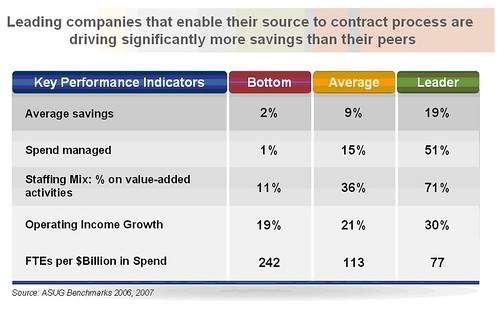
- SAP Community
- Products and Technology
- Additional Blogs by SAP
- Central Contract Management in the Business Suite
- Subscribe to RSS Feed
- Mark as New
- Mark as Read
- Bookmark
- Subscribe
- Printer Friendly Page
- Report Inappropriate Content
SAP SRM and the Business Suite
SAP Supplier Relationship Management's (SRM's) longstanding role has been a system where customers can manage their procurement organizations and systems centrally. Companies can accomplish centralized procurement with decentralized execution for corporate-wide spend management. In addition, SAP SRM has been providing customers with contract management capability for customers to align supplier networks, provide contract visibility, and achieve compliance, which leads to sustainable cost savings. Central procurement and contract management, among other capabilities, will continue to be SRM's contributions to the Business Suite
Central Contract Management
Procurement organizations are tapped to bring significant year over year savings to their company's bottom line. Contracts represent a significant opportunity for cost savings - both in full utilization of existing contracts and an increase in spend under contract. Sourcing processes have been the method for companies to achieve sustainable comparative cost advantage. In order to capture savings from sourcing activities, companies must ensure that the resulting contracts are understood and leveraged by diverse buying centers across the globe. SRM 7.0, which is part of Business Suite 7, offers central contract management with enhanced contract maintenance and distribution functionality to ensure discounts and savings get realized.
New in SRM 7.0
A central contract created in SRM can be distributed to multiple operational procurement systems, such as SRM and ERP-MM (Materials Management) systems. Thus, the contract is available to all operational procurement processes, including automated ordering (eg: Materials Resource Planning (MRP) or plan-driven procurement), manual requisitioning, or self-service procurement. The contract can be easily assigned to support user adoption and compliance. Pricing is determined using the central contract based on location, volumes, price schedules, and other contract pricing conditions. All call-off and maintenance history will be maintained in the central contract for tracking. Discounts based on volume thresholds will be more quickly identified as all the call-off volume is contained in a single contract.
By having the central contract repository in SRM, customer can take advantage of the SRM contract features. One notable feature is the contract hierarchy where customers can maintain contracts at different levels of a product or supplier hierarchy. Child nodes, for instance, can adopt changes to the parent nodes in the hierarchy for easy maintenance. Also, parent nodes will aggregate contract call-off volumes from child nodes to recognize volume thresholds and volume-based discounts.
The central contract in SRM coupled with the contract hierarchy delivers a central contract repository where contracts can be easily maintained, monitored, and distributed.
New Features in the SRM 7.0 Contract
- Central Contracts
- Additional contract information in the shopping cart sources of supply
- Maintain alerts in the contract header and items for target value, target quantity, and expiration.
- Distribute contract items to the internal catalog
- Change documents and version management for price conditions (audit trail)
- Exchange rate thresholds/tolerances
- Discount based on aggregated release value
- Contract mass update - multiple contracts can be updated, created, or appended from an accepted bid.
- Grouping of items
Centralized Sourcing and Contract Management Ensures Compliance with Contracts
Companies in the top performing group not only centralized their contract management processes, but also integrated central contract management with central sourcing, supplier management, and operational procurement processes to meet savings and spend under management objectives. The following are contract management best practices from top performing procurement organizations.
- Transfer negotiated terms and conditions seamlessly to operational procurement. Ensure that negotiated terms and conditions are applied and used consistently in operational procurement across local buying organizations.
- Unify and automate contract negotiation, creation, and execution processes to accelerate cycle time.
- Negotiate volume discounts on global spend.
- Attain central transparency of all contract releases across the organization. Realize consistent contract price and conditions for the same category.
- Monitor contract compliance and maverick buying. Increase compliance to maximize cost savings.
- Standardize and automate operational processes to maximize savings delivery, reduce operational costs, increase contract compliance, avoid maverick buying, and improve productivity.
- Increase the number of contractual relationships with global qualified supply base.
You probably noticed in the above the ties between contract management and other processes; the most prominent couplings are contract management with sourcing and operational procurement. SAP SRM contract management capability integrates with the Business Suite processes to ensure that these best practices can be fully realized.
Summary - Key Points
- SAP has the only solution that enables a company to centrally leverage a contract across all systems and geographies
- Various buying methods (automated ordering, manual order entry or employee end-user buying) can all use the same contract and pricing for aggregated discounts
- To support user adoption and compliance, central contracts are assigned easily during the operational procurement process
- Completely integrated within Suite (seamless operation with ERP-MM)
- Enables negotiated savings to become realized savings with increased contract compliance.
- Consuming SAP with SAP Build Apps - Mobile Apps for iOS and Android in Technology Blogs by SAP
- Preferred Alternative UoM for Warehouse Operation in EWM in Supply Chain Management Blogs by Members
- How to use Digital Manufacturing MDOs within PPD Example: Where-Used Report with Follow-up Actions in Product Lifecycle Management Blogs by SAP
- Advance Return Management complete configuration(SAP ARM) in Enterprise Resource Planning Blogs by Members
- When is the right time to compose? in CRM and CX Blogs by SAP


